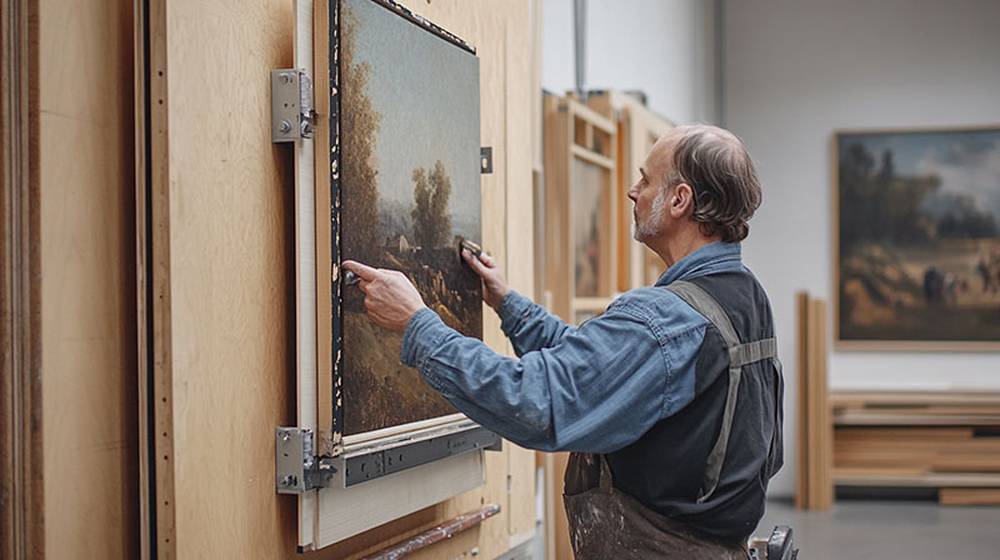
How to Frame Antique Oil Canvas Paintings
Antique oil paintings are more than decorative pieces. They are irreplaceable treasures that carry history, craftsmanship, and sentimental value. Whether it’s a family heirloom or a gallery acquisition, framing an antique oil painting must be done with extraordinary care. A poorly chosen frame or harmful materials can irreversibly damage the artwork.
In this detailed guide, we will walk you through how to frame antique oil canvas paintings without damaging them, covering everything from preparation, frame selection, mounting, and glazing, to long-term care. By the end, you’ll know exactly how to protect and display your masterpiece safely.
Why Framing Antique Oil Canvas Paintings Requires Special Care
Framing a new canvas or print is a straightforward task, but antique oil paintings are different. Here’s why they need a specialized approach:
Fragile Surfaces: Oil paint layers become brittle with age, making them prone to cracking or flaking.
Canvas Vulnerability: Old canvases may sag or weaken, especially if exposed to tension or moisture.
Environmental Sensitivity: Changes in humidity, temperature, and light can deteriorate antique oils faster.
Historical Value: Many antique paintings are rare or valuable, and any damage reduces both their financial and cultural worth.
Because of these risks, the framing process should not only enhance beauty but also provide long-lasting protection.
Step 1: Assess the Condition of the Painting
Before even thinking about frames, inspect the painting closely. Ask yourself:
Is the canvas stable, or does it show signs of sagging?
Are there cracks, peeling paint, or missing pigment?
Does the canvas need cleaning or relining?
Is the stretcher (wooden support) warped or damaged?
If you notice major issues, consult a professional art conservator before framing. Attempting to frame a fragile, flaking canvas on your own can worsen the damage.
Step 2: Choose the Right Frame Style
The frame must complement the painting without overwhelming it. For antiques, the frame also acts as a historical extension of the artwork. Consider these aspects:
1. Period-Appropriate Frames
For authenticity, many collectors prefer frames from the same era as the painting. For example:
Baroque paintings often suit ornate gilded frames.
Victorian artworks may pair well with heavy carved wood.
Early modern oils can look better in simpler, elegant frames.
2. Material Selection
Opt for high-quality, acid-free, and stable materials. Popular frame materials include:
Hardwood (oak, walnut, mahogany): Durable and traditional.
Gesso and gilded finishes: Classic and elegant but fragile.
Conservation-grade wood or composite: Treated to prevent off-gassing that can harm the painting.
3. Matching the Artwork
The frame should draw the eye toward the artwork, not overshadow it. Neutral tones or subtle gilding often work best with aged oils.
Step 3: Decide on a Liner or Mat
Unlike works on paper, oil paintings generally do not require mats. However, linen liners or wood fillets are often used to create visual separation between the canvas and frame.
Linen liners: Offer a traditional, breathable border and prevent direct contact between the canvas and frame.
Wood fillets: Small wooden strips that provide spacing without adding bulk.
Always use archival, acid-free materials for liners.
Step 4: Mounting the Painting Safely
Mounting is the most delicate part of framing antique oil canvas paintings. Never glue, tape, or staple directly into the artwork. Instead:
Use a Stretcher or Strainer
Most oil paintings are already stretched on wooden stretchers. If the stretcher is weak, replace it with a new conservation-grade stretcher that allows for expansion and contraction without stressing the canvas.Secure with Offset Clips or Brackets
Instead of nails or adhesives, attach the canvas to the frame using offset clips. These small, L-shaped brackets hold the stretcher in place without puncturing or compressing it.Avoid Pressure
Ensure the frame is slightly deeper than the painting to prevent the painted surface from touching the glazing or frame edges.
Step 5: To Glaze or Not to Glaze?
A common question when framing oil paintings is whether to add glass or acrylic glazing. Traditionally, antique oils were displayed without glazing, but modern conservation practices recommend considering it for extra protection.
Benefits of Glazing
Shields against dust, dirt, and pollutants.
Reduces UV exposure that can fade pigments.
Adds a physical barrier against accidental touches.
Potential Risks
If glazing touches the paint surface, it can cause condensation or sticking.
Poor ventilation can trap moisture, leading to mold.
Best Practice: Use UV-filtering, anti-reflective acrylic instead of glass. Always add a spacer so the glazing never touches the painting surface.
Step 6: Protect the Back of the Painting
The back of an antique oil painting is just as important as the front. Protect it by:
Backing Board: Use acid-free foam board or corrugated plastic to cover the back of the frame. This blocks dust and environmental pollutants.
Dust Cover: A sealed, breathable dust cover (archival kraft paper) helps prevent insect damage.
Breathability: Avoid airtight seals, oil paintings need to “breathe” to prevent trapped moisture.
Step 7: Hanging and Placement
Even the best frame cannot protect a painting if it’s hung improperly. Consider the following:
Avoid Direct Sunlight: UV rays cause fading and drying of oils.
Maintain Stable Humidity and Temperature: Ideal range is 40–55% humidity and 65–75°F.
Avoid Heat Sources: Keep away from fireplaces, radiators, and air vents.
Use Proper Hardware: D-rings and picture wire rated for the painting’s weight are safer than simple hooks.
Step 8: Long-Term Care and Maintenance
Framing is just the beginning. Antique oil canvas paintings require ongoing care:
Dust Gently: Use a soft, natural-hair brush. Never use cloths, sprays, or water.
Inspect Regularly: Look for new cracks, loose paint, or signs of insect infestation.
Re-frame if Needed: If materials deteriorate (e.g., acidic liners, rusty clips), replace them with archival options.
Professional Conservation: Have a conservator examine valuable pieces every few years.
Common Mistakes to Avoid When Framing Antique Oil Paintings
Using Adhesives or Tapes – These can stain, warp, or permanently damage the canvas.
Skipping Spacers with Glazing – Leads to paint sticking to the glass/acrylic.
Cheap or Acidic Materials – Non-archival wood, cardboard, or mats can leach acids and discolor the canvas.
Overly Tight Frames – Stress the stretcher bars and risk paint cracking.
Hanging in Damp or Hot Environments – Kitchens, bathrooms, and basements are poor choices for valuable art.
DIY vs. Professional Framing
While DIY framing may be tempting, antique oil canvas paintings often deserve professional care. Here’s a quick comparison:
| Aspect | DIY Framing | Professional Framing |
|---|---|---|
| Cost | Lower upfront | Higher investment |
| Skill Required | Moderate to advanced | Expert knowledge and tools |
| Risk of Damage | Higher | Lower (if done by conservators or experts) |
| Materials Access | Limited to retail conservation supplies | Access to museum-grade archival materials |
| Best For | Less valuable or practice works | Antique, valuable, or fragile artworks |
If the painting holds significant financial or sentimental value, investing in a professional framer or conservator is strongly recommended.
Advanced Conservation Framing Techniques
For collectors and museums, additional techniques can add layers of protection:
Microclimate Frames
These sealed frames create a controlled environment, ideal for sensitive works in fluctuating climates.Hygroscopic Materials
Certain liners or spacers can buffer humidity changes, reducing stress on the canvas.Vibration Reduction Mounts
Special systems minimize vibration damage during transport or when displayed in high-traffic areas.
How to Frame Antique Oil Canvas Paintings Without Damaging Them: Quick Checklist
Inspect painting condition first.
Choose a period-appropriate, conservation-grade frame.
Use archival liners or fillets, never acidic mats.
Mount with offset clips, not nails or adhesives.
Consider UV-filtering acrylic glazing with spacers.
Protect the back with acid-free backing boards.
Hang in stable, low-light, climate-controlled areas.
Maintain and inspect regularly.
Framing antique oil paintings is both an art and a science. Done correctly, it enhances the painting’s beauty while preserving it for generations. Done carelessly, it can cause irreversible harm.
By using archival materials, gentle mounting methods, protective glazing, and proper placement, you can safeguard your artwork without compromising its integrity. If in doubt, always seek professional conservation framing services.
Remember: A frame isn’t just decoration, it’s a protective shell that allows your antique oil painting to endure and inspire for decades, even centuries to come. image/ russell-collection




